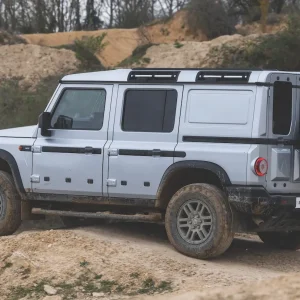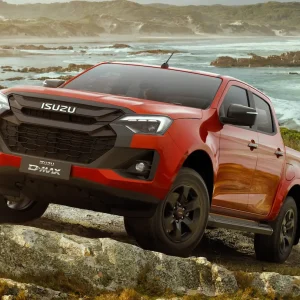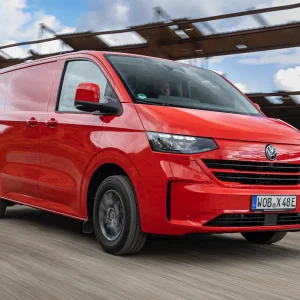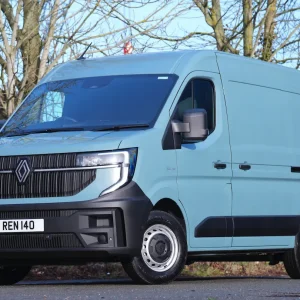Renault has revamped its electric Kangoo with a more powerful electric motor, a bigger battery and a longer range between recharges.
The previous model was equipped with a 44.7kW (60hp) motor married to a 33kWh battery, offering a claimed range of 143 miles. The new Kangoo E-Tech boasts a 90kW (120hp) motor backed by a 45kWh battery delivering an anticipated 186-mile range; shame it cannot quite get over that 200-mile barrier.
The changes form part of an overall revision of Kangoo that helped it win the What Van? Compact Van of the Year Award in 2023. Changes include a restyled exterior with C-shaped LED daytime running lights and a reimagined cab interior.
Businesses that have yet to be converted to zero-emission technology will be reassured by the availability of a 1.5-litre diesel at either 95hp or 115hp and a 1.3-petrol engine at 100hp.
Kangoo and Kangoo E-Tech customers can choose either a short- or a long-wheelbase model with load cubes of 3.3m3 and 4.2m3 respectively. Two trim levels are up for grabs; Start or the more upmarket Advance.
Keen to burnish our credentials as guardians of the environment, we opted to sample a short-wheelbase E-Tech in Advance specifications; with a long list of extra-cost options.
Load bay
Access to the cargo bay – complete with LED lighting – is by means of a sliding door on each side or through asymmetric twin back doors. The narrower of the two is on the offside.
They can be swung through 90° or through 180° if you release the stays, and open to reveal a load bay with 10 tie-down points. A 12-volt power point is positioned near the offside rear door.
A plastic full-height bulkhead is fitted, presumably for the sake of lightness. While it looks robust enough, as traditionalists we tend to favour a steel partition.
The bulkhead bulges backwards, and restricts access (albeit modestly) through the side doors.
Our demonstrator’s cargo area was comprehensively timbered out, with plywood protecting most of the areas vulnerable to damage, including the floor and the wheel boxes. Plastic panels help protect the doors.
At just 608kg, payload capacity is considerably below that of the cheaper equivalent diesel model, but braked towing capacity is a healthy 1,500kg.
Interior and equipment
Fitting an interior rear-view mirror is pointless if you have an opaque bulkhead, so Renault decided to equip our demonstrator with an optional camera that shows what is behind you at all times. The picture is shown on a dedicated screen.
Initially we felt it was distracting, but we soon got used to it and appreciated its clarity.
At a cool £800, however, – all prices quoted here exclude VAT – the price is eye-watering. So, it would be understandable if buyers decided to rely solely on the heated, electrically-adjustable, exterior rear-view mirrors instead.
That said, do not forget the wide-angle mirror mounted on the inside of the sun visor. It should enable you to spot a cyclist who would otherwise be invisible edging down your nearside.
The aforementioned camera is separate to the reversing camera – another option – that delivers a different, close-quarters, image to the touchscreen in the centre of the dashboard. The reversing sensors that complement it are standard.
The 8.0in Easy Link touchscreen controls the infotainment system, with Bluetooth connectivity, Android Auto, Apple CarPlay and a DAB radio all present, along with a 12-volt power socket and USB ports. Our test van boasted an optional smartphone dock.
Remote controls for the radio are housed on a small stalk on the steering column that can be quite difficult to see when you are sitting behind the wheel.
Our Kangoo E-Tech did not come with an ignition key, but instead featured an optional keycard that must be present when you press the button which starts the vehicle.
The same card is used to lock and unlock the battery charging flap and the doors. The cab doors and load bay doors can be locked and unlocked separately.
The electric parking brake can engage and disengage itself automatically. Other handy features include a driver’s airbag and electric windows.
Manual air-conditioning is fitted and it is pleasing to see that both it and the heating and ventilation system are governed by big, chunky, easy-to-understand, knobs. No need to keep prodding the touchscreen in the hope that you will be able to figure out how
to raise the temperature a notch.
Theoretically, the cab is a three-seater. In practice though whoever sits on the impractical middle perch will have to be short, thin and not mind being squashed between the driver and the other passenger.
The centre seat offers one benefit; its back can be folded down and turned into an impromptu desk with a pen tray, a cup-holder and an elasticated strap to keep your paperwork tidy.
The driver’s seat and the steering column are both height-adjustable. Our van boasted an optional heated and a leather-trimmed steering wheel.
In-cab storage facilities include a shelf above the windscreen, bins in each of the doors, a lidded but not lockable glove box, and shelves at the top and bottom of the dashboard. Adjacent to the latter shelf is a cup-holder.
On-board safety features include ABS with emergency brake assist, electronic stability control, hill start assist and traction control system. The last-named can be switched off if necessary.
Our test van came with a mountain of optional safety features, at least some of which should be provided as standard. The line-up included active emergency braking system, advanced lane keep assist, and blind spot intervention.
Also installed were adaptive cruise control and highway and traffic jam assist, both of which have the same objective; ensuring you maintain a safe distance between your vehicle and the vehicle in front while driving.
The headlights illuminate automatically at dusk and a spattering of rain will trigger the windscreen wipers.
Disc brakes are fitted all round and our test van sat on optional 16in alloy wheels shod with Continental Eco Contact 205/60 R16 tyres.
Powertrain
Married to a single-speed transmission, the electric motor delivers 245Nm of torque. The charging socket for the lithium-ion battery, which is protected by a cooling system, is at the front of the van, beneath the big Renault logo which flips to one side.
A mode 3-type charging cable is supplied with the vehicle.
Driving
If you want to maximise your range and you are tackling a reasonably hilly route, then make sure you make full use of Kangoo E-Tech’s regeneration system whenever you go down an incline.
Tap the shift lever to the right and select B1, B2 or B3 – the maximum – and you will get lots of lovely free energy pumped into the battery when you lift your foot off the accelerator pedal. It is remarkably effective and unlike regeneration packages fitted to earlier electric Renaults it does not result in nearly being jerked out of the driving seat every time you use it.
A display on the instrument panel – an optional 4.2in colour display in our case – tells you how much charge is going into the battery, and how much range you have got left.
Another way of extending the gap between recharges is to press the ‘Eco’ button on the dashboard. You lose some performance by doing so, but you will experience surprisingly little impact if you are lightly laden, and the air-conditioning is not affected.
Leave the button alone, and you will find on-highway performance is more than acceptable, with brisk acceleration and relaxed motorway cruising. Remember, though, that the harder you press the loud pedal, the faster the range will drop.
Manoeuvring at low speeds can be a little awkward at times, however, because the Kangoo E-Tech is not that biddable.
You have to tickle it along. If you are over-enthusiastic with your right foot then there is the risk that the van will suddenly shoot forwards; and spoil your entire day.
The Renault handles well but as with most light commercials, the ride can be choppy when you are lightly-laden.
The muted whirring of the electric motor means all the other potential sources of noise – the tyres smacking the road surface, for example – become more noticeable. Artificial noise is generated at low speeds to alert other highway users to the van’s presence.
Operating
Service intervals are set at one year/12,000 miles for the first year, then every two years/24,000 miles thereafter.
Kangoo E-Tech is protected by a three-year/100,000-mile warranty, with the battery covered for eight years/100,000 miles. The anti-corrosion warranty runs for 12 years while the paintwork warranty lasts for three years.
Charging times range from less than seven hours if you hook your van up to a wallbox, says Renault, to 42 minutes – which will get you to 80% of the battery’s capacity – with a 75kW DC rapid charger. You may be able to use the MyRenault app to schedule charging or switch on the air-conditioning or the cab heater remotely using your smartphone.
Rather than a spare wheel, you get a tyre inflator/sealer that sits under the passenger seat. As with the plastic bulkhead, the aim presumably is to save weight.
There are no side rubbing strips to protect the body from minor scrapes; an unfortunate omission.
Renault Kangoo ML19 E-Tech Advance
Price (ex VAT) £32,350**
Price range (ex VAT) £31,350–33,850**
Gross payload 608kg
Load length 1806mm
Load width (min/max) 1248mm/1570mm
Load bay height 1215mm
Load volume 3.3m3
Loading height 635mm
Rear door aperture 1256mm x 1117mm
Side door aperture 736mm x 1054mm
Gross vehicle weight 2230kg
Braked trailer towing weight 750kg/1500kg
Residual value 29.4%*
Cost per mile 48.0p
Electric motor 90kW (120hp)
Torque 245Nm
Gearbox 1sp
Range (WLTP combined) 186 mls
Battery 45kWh
Warranty 3yrs/100,000 mls (battery 8yrs/100,000 mls)
Service intervals 2yrs/24,000 mls
Insurance group 34E
Price as tested £37,135
* After 48 months/20,000 mls p.a – source – KWIKcarcost
** Basic price before VAT, On The Road costs, and government Plug-in Van Grant
Options
Active Emergency Braking System £450
Adaptive Cruise Control £480
Advanced Lane Keep Assist £550
Blind Spot Intervention £350
Wooden load area floor and side panels £500
Heated leather-trimmed steering wheel £60
Rear parking camera £450
Rear view assist camera 5ins screen £800
Smartphone dock £20
Highway and Traffic Jam Assist £500
4.2ins colour driver info screen £75
Alloy wheels £400
Key card £150
Rivals
Maxus eDeliver 3
Price range (ex VAT) from £34,000
Load volume 4.8m3
Gross payload 865-905kg
Electric motor 90kW (120hp)
Verdict: Bigger than Kangoo E-Tech and sensibly offering customers the choice of two different battery packs; eDeliver 3 is shipped in as a chassis cab as well as in panel van guise. The 200-mile-plus range predictions made by the manufacturer seem to be accurate, and eDeliver 3 is certainly worth a second glance if you need more space and payload capacity than the Renault offers.
Peugeot e-Partner
Price range (ex VAT) £32,385–34,840
Load volume 3.3-3.8m3
Gross payload 751-803kg
Electric motor 100kW (134hp)
Verdict: A little behind some of its key competitors so far as range between recharges is concerned, it remains a sensible choice nevertheless, with a decent payload capacity and a good standard of ride and handling. Don’t forget that the same model is marketed by Citroën as the e-Berlingo, by Fiat Professional as the E-Doblo, by Vauxhall as the Combo-e and by Toyota as the Proace City Electric.
Volkswagen ID. Buzz Cargo
Price range (ex VAT) £39,625–43,875
Load volume 3.9m3
Gross payload 592-607kg
Electric motor 150kW (201hp)
Verdict: Looks like nothing else on the highway and will certainly ensure your business stands out from the pack. Plenty of power and a claimed 250-mile-plus range, but the front-end price is steep, and payload capacity is modest. Great stress is laid on built-in safety though, which we can only applaud. No long-wheelbase version is available, and none on the horizon, alas.
The Final Verdict
Design 8/10 – More evolution than revolution, with its attractively-styled exterior and stylish interior
Cabin 7/10 – Pleasant with some useful features, but why pretend it’s a three-seater when it isn’t?
Ride 7/10 – Uneven when lightly-laden but gets smoother the more weight you load on board
Refinement 7/10 – Well put together, but wind and tyre noise are undoubtedly intrusive
Load area 7/10 – Decent level of access from three sides, but modest payload capacity.
Handling/performance 9/10 – Both are well up to scratch, with little to criticise
Engine/transmission 8/10 – A much-improved package, with more horses and a longer range
Standard equipment 6/10 – Too many safety-related items are extra-cost options. Time for a rethink Renault.
Operating costs 8/10 – Running expenses should be less than those of an equivalent diesel
What Van? subjective rating 8/10 – Represents solid progress rather than a great leap forward
Overall Rating = 75/100





